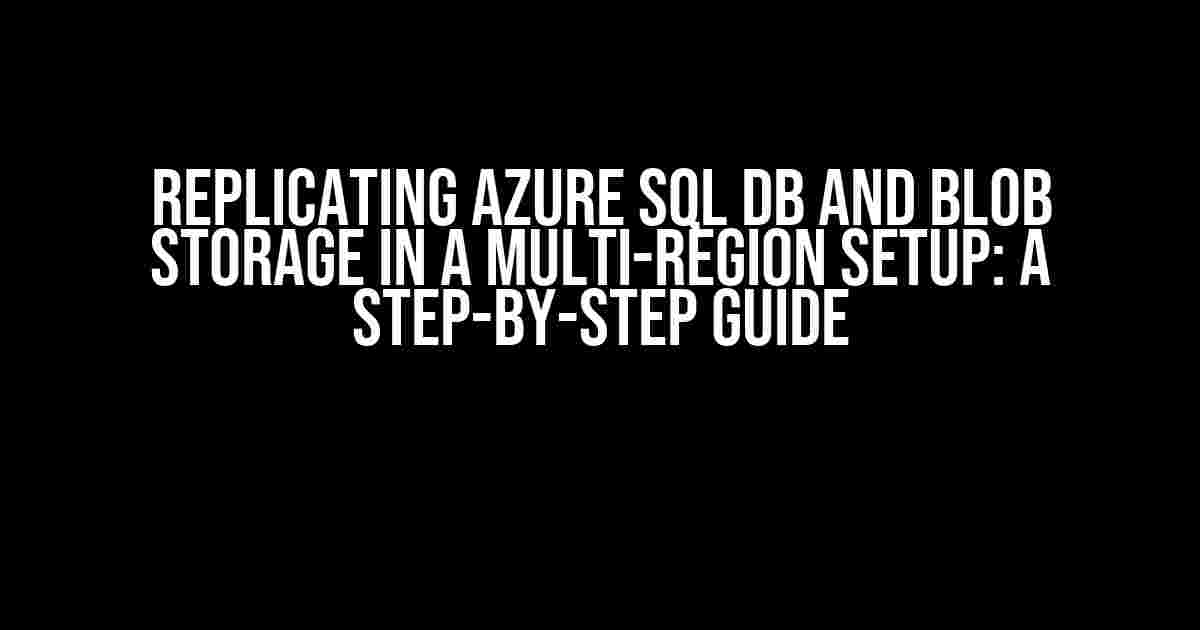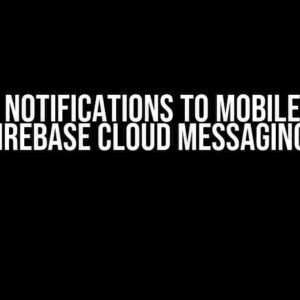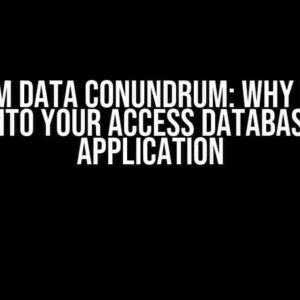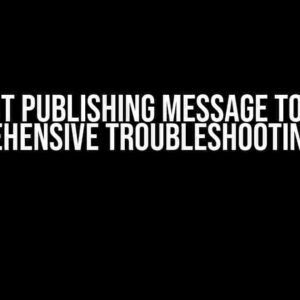Are you tired of dealing with latency and downtime issues in your Azure-based applications? Do you want to ensure high availability and disaster recovery for your critical data? Look no further! In this article, we’ll take you through the process of replicating Azure SQL DB and blob storage in a multi-region setup, ensuring your data is always accessible and up-to-date, no matter what region your users are in.
Why Multi-Region Replication Matters
In today’s digital age, users expect fast and seamless experiences, no matter where they are in the world. With the rise of cloud computing, businesses can now reach a global audience, but this comes with its own set of challenges. Latency, data sovereignty, and disaster recovery are just a few concerns that can make or break your application’s success. That’s why replicating your Azure SQL DB and blob storage across multiple regions is crucial for:
- Reducing latency: By having data centers in close proximity to your users, you can reduce latency and improve overall performance.
- Ensuring data sovereignty: With data replication, you can ensure that your data remains in specific regions, complying with local regulations and laws.
- Disaster recovery: In the event of an outage or disaster, having replicated data in multiple regions ensures business continuity and minimal data loss.
Setting Up Azure SQL DB Replication
Before we dive into the replication process, make sure you have:
- Azure SQL Database instances in each region you want to replicate to
- Active Directory (AAD) authentication set up for each instance
- TCP/IP connectivity between instances
Now, let’s get started!
Step 1: Create a Database Master Key (DMK)
CREATE MASTER KEY ENCRYPTION BY PASSWORD = 'YourStrongPassword';
Run the above command in the master database of your primary Azure SQL Database instance.
Step 2: Create a Certificate for Encryption
CREATE CERTIFICATE [ertificate_Name] WITH SUBJECT = 'CN=ReplicaCert';
Create a certificate in the master database of your primary Azure SQL Database instance.
Step 3: Create a Database Encryption Key (DEK)
CREATE DATABASE ENCRYPTION KEY WITH ALGORITHM = AES_256 ENCRYPTION BY CERTIFICATE [Certificate_Name];
Create a DEK in the database you want to replicate, using the certificate created in Step 2.
Step 4: Enable Transparent Data Encryption (TDE)
ALTER DATABASE [Database_Name] SET ENCRYPTION ON;
Enable TDE on the database you want to replicate.
Step 5: Create a Replica URL
CREATE ENDPOINT FOR DATABASE_MIRRORING (ROLE = '.replica', AUTHENTICATION = (AUTHENTICATION = 'AAD'));
Create a replica URL in the primary Azure SQL Database instance.
Step 6: Add the Replica URL to the Secondary Instance
ALTER DATABASE [Database_Name] ADD MIRRORING (ROLE = 'partner', PARTNER = '[Replica_URL]');
Add the replica URL to the secondary Azure SQL Database instance.
Replicating Azure Blob Storage
Now that we’ve covered Azure SQL DB replication, let’s move on to replicating Azure blob storage.
Step 1: Create a Storage Account in Each Region
Create a storage account in each region you want to replicate to. Make sure to enable:
- Versioning
- Soft Delete
- Container-level Azure Active Directory (AAD) authentication
Step 2: Create a Container in Each Storage Account
Create a container in each storage account, using the same name and permissions.
Step 3: Configure Cross-Region Replication
az storage container create --name [Container_Name] --account-name [Storage_Account_Name] --resource-group [Resource_Group_Name] --location [Location]
Use the Azure CLI to create a container in each storage account, specifying the region and resource group.
Step 4: Set Up Blob Storage Firewall Rules
az storage container update --name [Container_Name] --account-name [Storage_Account_Name] --resource-group [Resource_Group_Name] --default-action Allow
Configure firewall rules to allow traffic between regions.
Step 5: Replicate Blobs Using AzCopy
azcopy copy "[Source_Blob_URL]" "[Destination_Blob_URL]" --recursive --preserve-smb-permissions --preserve-smb-acls
Use AzCopy to replicate blobs between storage accounts, preserving permissions and ACLs.
Troubleshooting and Monitoring
To ensure seamless replication, monitor and troubleshoot your setup regularly:
- Monitor Azure SQL Database instance performance and latency
- Check blob storage replication status and errors
- Verify data consistency between regions
- Test disaster recovery and failover scenarios
Conclusion
Replicating Azure SQL DB and blob storage in a multi-region setup requires careful planning and execution. By following this step-by-step guide, you’ll be able to ensure high availability, disaster recovery, and data sovereignty for your critical applications. Remember to monitor and troubleshoot your setup regularly to ensure seamless replication and minimal downtime.
| Region | Azure SQL DB Instance | Storage Account | Container Name |
|---|---|---|---|
| North America | sql-db-northamerica | storage-northamerica | mycontainer |
| Europe | sql-db-europe | storage-europe | mycontainer |
| Asia | sql-db-asia | storage-asia | mycontainer |
This table illustrates a sample multi-region setup with Azure SQL DB instances and storage accounts in North America, Europe, and Asia.
Remember to adapt this guide to your specific use case and requirements, and don’t hesitate to reach out to Azure support if you encounter any issues during the replication process.
Frequently Asked Question
Here are some frequently asked questions about replicating Azure SQL DB and blob storage in a multi-region setup.
Q: What are the benefits of replicating Azure SQL DB in a multi-region setup?
Replicating Azure SQL DB in a multi-region setup provides high availability, disaster recovery, and low latency for applications. It ensures that your database is always available, even in the event of a regional outage or disaster. Additionally, it allows you to deploy your application in multiple regions, reducing latency and improving the overall user experience.
Q: Can I replicate my Azure Blob Storage across multiple regions?
Yes, you can replicate your Azure Blob Storage across multiple regions using Azure Storage replication. This allows you to store your data in multiple locations, providing high availability and disaster recovery. You can choose from three types of replication: Locally Redundant Storage (LRS), Zone-Redundant Storage (ZRS), and Geo-Redundant Storage (GRS).
Q: How do I configure Azure SQL DB replication across multiple regions?
To configure Azure SQL DB replication across multiple regions, you need to create a database in each region and configure active geo-replication. This involves creating a primary database in one region and one or more secondary databases in other regions. You can then configure the databases to automatically failover in case of an outage.
Q: What is the latency impact of replicating Azure Blob Storage across multiple regions?
The latency impact of replicating Azure Blob Storage across multiple regions depends on the type of replication you choose. For example, with GRS, data is replicated asynchronously across regions, which may introduce some latency. However, with ZRS, data is replicated synchronously across Availability Zones, which minimizes latency. You need to carefully consider your latency requirements and choose the right replication strategy for your application.
Q: How do I ensure data consistency across replicated Azure SQL DB and blob storage?
To ensure data consistency across replicated Azure SQL DB and blob storage, you need to implement a transactions-based approach. This involves using Azure Cosmos DB’s globally distributed, multi-model database service to provide strong consistency and low latency. You can also use Azure Transactional Replication to replicate data across regions, ensuring data consistency and integrity.




